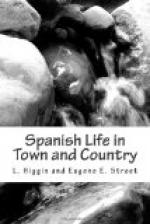While the old church of Atocha was still standing, the Court, with a royal escort, or what is called escadron de salut, all the dignitaries of the Palace in attendance, guards, outriders, etc., in gorgeous array, drove in half state (media gala) across Madrid and the paseos to hear the salut “sa’nt" on Saturday. The Queen Regent and her daughters, but not often the King, now visit in turn some of the churches, but without the old state or regularity.
Since the death of Alfonso XII., many of the purely Spanish customs of the Court have been modified or discontinued. Although the late King was credited with a desire to reduce the civil list, and to adopt more English customs, he was to some extent in the hands of the Conservatives, who had been the means of his restoration, and when he went forth to put an end to the Carlist insurrection and finish the civil war, which had laid desolate the Northern provinces and ruined commerce and industry for some seven years, it was at the head of a personal following of over five hundred people. Nor was the Court much, if any, less numerous when the Royal Family removed in the summer to the lovely Palace of St. Ildefonso at La Granja—that castle in the air, which has no equal in Europe, hanging, as it does, among gardens, forests, rivers, and lakes, three thousand eight hundred and forty feet above the level of the sea.
The Queen is Austrian, and she has never gone out of her way to conciliate the people by making herself really Spanish. This she has left to the Infanta Isabel, the eldest sister of Alfonso XII. For many years before the birth of her brother, the Infanta Isabel was Princess of Asturias, as heiress apparent of the Crown. With the advent of a boy, she became, of course, only Infanta, losing the rank which she had held up to this time. Being but a child at the time, she perhaps knew or cared little for any difference it may have made in her surroundings. She shared in the flight of the Royal Family to France in 1868, and her education was completed in Paris. When the whirligig of Spanish politics called her brother Alfonso, who at the time was a military student at Sandhurst, to the throne from which his mother had been driven, Princess Isabel returned with him to Madrid, and was once more installed in the Palace, above the Manzanares, as Princess of Asturias. This rank remained hers during the short episode of her brother’s marriage to his cousin Mercedes, and the melancholy death of the girl Queen at the moment when a direct heir to the throne was expected. Once more, when the daughter of Alfonso’s second wife, the present Queen Regent, was born, the Infanta Isabel became her title, and she took again the lower rank.




